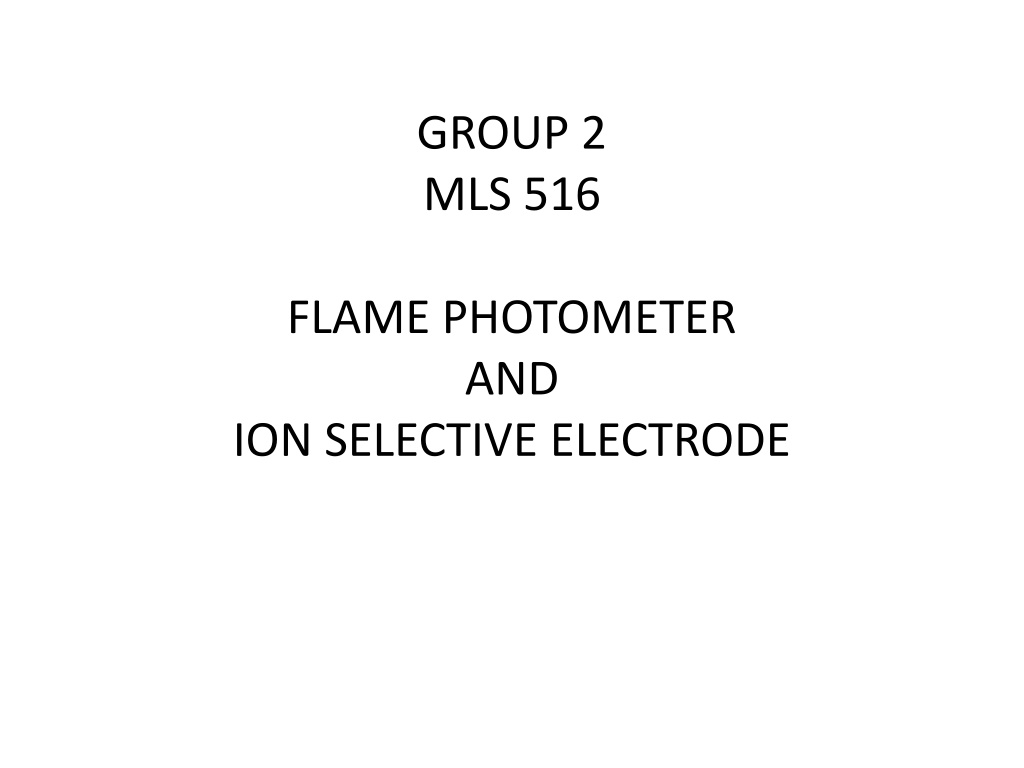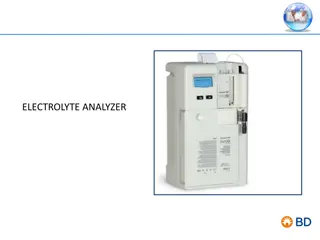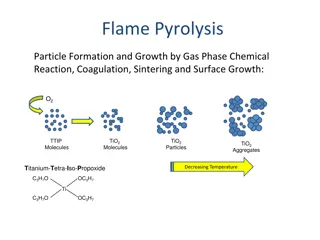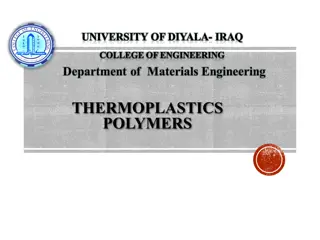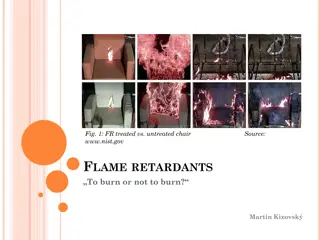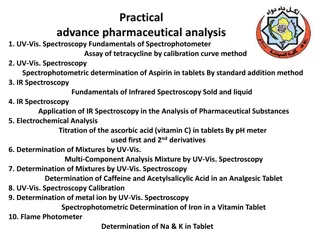Understanding Flame Photometry and Its Applications
A photoelectric flame photometer is utilized in inorganic chemical analysis to determine metal ion concentrations such as sodium, potassium, lithium, barium, and calcium. The photometer measures light intensity emitted when elements are exposed to a flame. By controlling flame color intensity, the device quantifies absorbed energy in atoms, enabling accurate concentration analysis. Components include a flame, mixing chamber, filters, and a photo detector, with applications spanning industries like potash, fertilizer, drinking water treatment, and glass.
Download Presentation

Please find below an Image/Link to download the presentation.
The content on the website is provided AS IS for your information and personal use only. It may not be sold, licensed, or shared on other websites without obtaining consent from the author. Download presentation by click this link. If you encounter any issues during the download, it is possible that the publisher has removed the file from their server.
E N D
Presentation Transcript
GROUP 2 MLS 516 FLAME PHOTOMETER AND ION SELECTIVE ELECTRODE
GROUP 2 Onokpe Frances OgheneFejiro -Presenter 15/Mhs06/051 Dandutse Tijjani Hajara Ogunyemi Tosin Eshegbe Ezekiel 15/MHS06/023 15/MHS06/043 14/MHS06/022
INTRODUCTION A photoelectric flame photometer is a device used in inorganic chemical analysis to determine the concentration of certain metal ions, which include sodium, potassium, lithium, barium and calcium. There is no need for light source because the flame serves both as an as an atomizer and excitation source. Flame Photometry works by measuring the intensity (measured using a wavelength of a color) when the element is exposed to a Flame (Hamza et al., 2013). of light emitted
PRINCIPLE flame test It is a controlled intensity of the flame color quantified by the photoelectric circuit. The intensity of the colour will depend on the energy that has been absorbed by the atoms that was sufficient to vaporise them. The sample is introduced into the flame, filters select the colors the photometer detects and exclude the influence of other ions (Hamza et al., 2013). which the
MODE OF ACTION This instrument consist of four basic components: a flame or burner, mixing chamber, color filters, and a photo detector. In a flame photometer, the solution is aspirated through a nebulizer (or aspirator) into the flame. After the sample matrix evaporates, the sample is atomized. Atoms then reach an excited state by absorbing heat from the flame. When these excited atoms return to their lowest- energy state, they give off colours in certain wavelengths, leading to the creation of a line spectrum. A filter pre-selected based on the atom being analyzed is used in flame photometry. The emission line s intensity is then practically measured and is related to the solution s original concentration
APPLICATIONS Potash and fertilizer industry Highly accurate determination of potassium and sodium concentrations Drinking water treatment Measurement of calcium and sodium concentrations in drinking water Glass industry Measurement of sodium concentrations in glass (Doku and Gadzekpo, 2009).
Clinical applications Electrolyte determinations in blood and urine Soft drinks, fruit juices and alcoholic beverages can also be analysed by using flame photometry to determine the concentrations of various metals and elements (Doku and Gadzekpo, 2009).
ADVANTAGES It is a fast and sensitive analytical method. It is very simple and economical. It is suitable for many metallic elements (Segundo et al., 2006). DISADVANTAGES It is expensive. Flame photometry cannot be used for the direct determination of every metal atom. Frequent calibration and care should be taken because it is affected by many variables (Almieda et al., 2009).
PRECAUTION Avoid handling samples with fingers. This leads to serious contamination. All analyses involve the use of a diluent, which is almost always deionised water. Standards and samples should not be exposed to the atmosphere for long periods (Carbonell et al., 2014).
ION SELECTIVE ELECTRODE
INTRODUCTION An ion-selective electrode (ISE) is an electro- analytical sensor with a membrane whose potential indicates the activity of the ion to be determined in a solution . There are commonly more than one types of ions in solution. This is done by applying a selective membrane at the ion selective electrode, which only allows the desired ion to go in and out (Wardak, 2011).
PRINCIPLE The ion selective electrode consists of a thin membrane across which only the intended ion can be transported. The transport of ions from a high concentration to a low concentration through a selective binding with sites within the membrane creates a potential difference.
TYPES Glass membranes: are made from an ion- exchange type of chalcogenide). It has a good selectivity, but only for several single-charged cations mainly H+, Na+, and Ag+. The glass membrane has excellent chemical durability and can work in very aggressive media. An example of this type of electrode is the pH glass electrode (Bogan and Agnes, 2002). glass (silicate or
Crystalline membranes are made from mono- or poly-crystallites of a single substance. They have good selectivity, because only ions which can introduce themselves into the crystal structure can interfere with the electrode response (Bogan and Agnes, 2002). Liquid membrane electrodes: An ion-exchanger or ionophore (neutral macrocyclic ion carrier) is dissolved in a viscous organic liquid membrane. Without the exchanger or ionophore the ion of interest is unable to penetrate the membrane (Bogan and Agnes, 2002).
Polymer membrane electrodes: An alternative to wet liquid membrane electrodes is to use a polymeric membrane, which is composed of a polymer such as polyvinylchloride (PVC), a plasticizer, and the ion carrier or exchanger The response of these electrodes is highly selective and they have replaced many liquid membrane electrodes. Polymer electrodes have been used to determine ions such as K+, Ca2+, Cl- and NO3 (Bogan and Agnes, 2002).
MODE OF ACTION Ion-selective electrodes possess a high degree of selectivity. The selectivity of the ISE is determined by the membrane. Ideally the membrane allows the uptake of only one specific ion into it. The analyte ion may be a cation or an anion. (Ceresa, 2001). composition of the
Within the ion selective electrode, there is an internal reference electrode, which is made of silver wire coated with solid silver chloride, embedded in concentrated potassium chloride solution (filling solution) saturated with silver chloride. This solution also contains the same ions as that to be measured. The electrode are connected by a milli-voltmeter. Measurement is accomplished immersing the two electrodes in the same test solution (Vigassy, 2003). ion selective electrode and reference simply by
APPLICATIONS Analysis of environmental samples Groundwater monitoring Fluoride detection around aluminum mills Biomedical laboratories measuring the concentration of ions in bodily fluids (Lenik et al., 2002).
CARE AND MAINTAINANCE Dirt and contamination on the sensor and diaphragm lead to measurement inaccuracies. They can be removed by diluted HCL, use of suitable solvents. After cleaning, rinse off the ISEs with distilled water, do not rub dry. Calibrate the ISE according to the operating manual of the ISE meter and the analysis specification. Store the electrode in a dry place.
REFERENCES Carbonell, V., Sanz, A., Salvador, A. and. DelaGuardia, M . (2014). Flow injection flame atomic spectrometric determination of aluminium, iron, calcium, magnesium, sodium and potassium in ceramic material by on-line dilution in a stirred chamber. Journal of Analytical Atomic Spectrometry.6 (3) :233 238. Almeida, M. I. G. S., Segundo, M. A., Lima, J. L. F. C., and Rangel, A. O. S. S. (2009). Interfacing multisyringe flow injection analysis to flame atomic emission spectrometry: an intelligent system for automatic sample dilution and determination of potassium, Journal of Analytical Atomic Spectrometry. 24(3):340 346. Bakker, E., and Pretsch, E. (2005). Potentiometric sensors for trace-level analysis. Trend. Anal. Chem. 24 :199 207. Bogan, M. J., and. Agnes ,G. R. (2002) Poly(ethylene glycol) doubly and singly cationized by different alkali metal ions: relative cation affinities and cation-dependent resolution in a quadrupole ion trap mass spectrometer . Journal of the American Society for Mass Spectrometry. 13(2): 177 186.
Ceresa, A., Sokalski, T., and Pretsch, E. (2001). Influence of key parameters on the lower detection limit and response function of solvent polymeric membrane ion-selective electrodes, Journal of Electroanalytical Chemistry. 501: 70 76 Doku, G. N., and Gadzekpo, V. P. Y. (2009). Simultaneous determination of lithium, sodium and potassium in blood serum by flame photometric flow-injection analysis .Talanta. 43(5): 735 739. Hamza, A.O.M., Mohammed, R.A.A., Elkhalifa, I.O.E., and Khider, M.O. (2013). Effectiveness of calibration on flame photometer performance , Int. J. Biomedical Engineering and Technology. 12(4): 334 345. Lenik, J., Dumkiewicz, R., Wardak, C., Marczewska, B. (2002). Naproxen ion-selective electrode and its application to pharmaceutical analysis. Acta Pol. Pharm. 59: 171 176. Segundo, M. A., Almeida, M. I. G. S., Lima, J. L. F. C., and RangeI, A. O. S. S.( 2006). Potentiometric multi-syringe flow injection system for determination of exchangeable potassium in soils with in-line extraction. Microchemical Journal. 83(2):75 80. Vigassy, T., Gyurcs nyi, R. E., and Pretsch, E. (2003 ). Influence of incorporated lipophilic particles on ion fluxes through polymeric ion- selective membranes. Electroanalysis. 15: 375 382. Wardak, C. A. (2011). Highly selective lead-sensitive electrode with solid contact based on ionic liquid. J. Hazard. Mater.186: 1131 1135.
